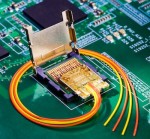After testing the Iomega USB 3.0 SSD extensively both in terms of benchmarks and real-world usability, I’m sold on it. the only outstanding question is the high price of the unit: The 64 GB drive starts at an attainable $190, but the big 256 GB drive is downright expensive at $620 (street price). It’s hard to knock the drive’s performance, component choices, or build quality, but is it worth more than a budget laptop?
USB 3.0
Infographic: Real-World Port Throughput Relative To Thunderbolt (Formerly Light Peak)
Just how fast is 10 gigabits per second anyway? To help out, I’ve prepared another napkin-tastic infographic!
What If Light Peak Was Electrical Rather Than Optical?
As I considered the possibilities of the new Apple/Intel interconnect technology known as Light Peak, an odd parallel with 10 Gb Ethernet popped into my head. Much of the confusion around Light Peak revolves around connectors, power conduction, and backward-compatibility. Then, like the Grinch, I thought of something I hadn’t before: Why use optical at all? 10 GBASE-T does just fine over twisted pair, and short interconnect distances would reduce power draw to reasonable levels. What if Light Peak was electrical rather than optical?
Light Peak + USB 3.0 = Awesome!
Yesterday I talked about Light Peak, the new optical interconnect being developed by Apple, Intel, and others. Today I’m continuing that theme, suggesting a possible productization that would really take Light Peak to the next level: Integrating it with USB 3.0.
Is Everyone Wrong About Light Peak?
Light Peak isn’t anything yet; it doesn’t exist. But I don’t think Light Peak will become the USB 3.0-killer that many folks suggest. Light Peak is a cabling spec only, not a new protocol that will eliminate everything that currently exists. In other words, Light Peak is a “middle connection” between a computer and peripherals that will retain compatibility with USB, HDMI/DVI, and Ethernet.




